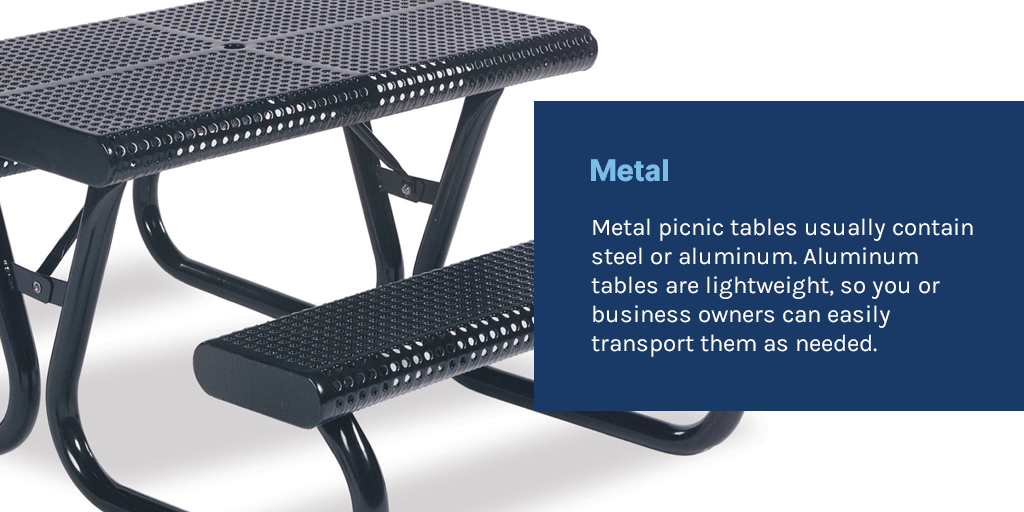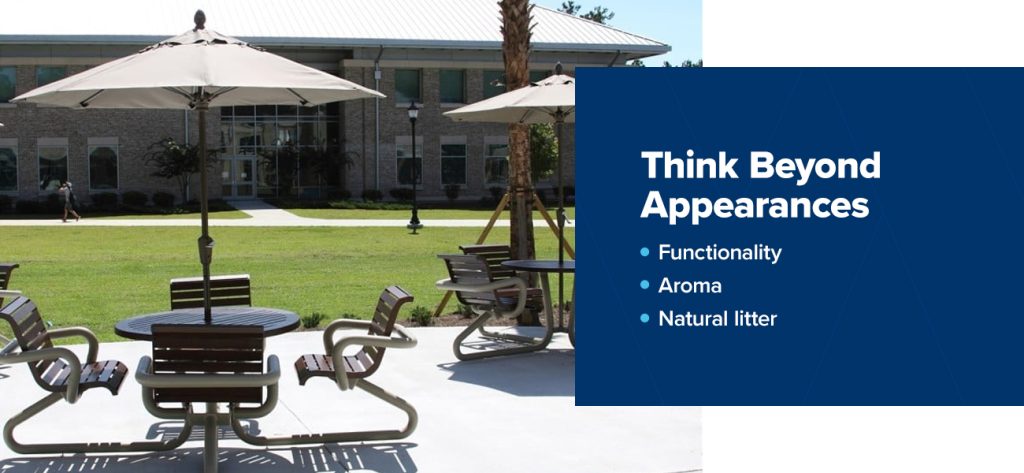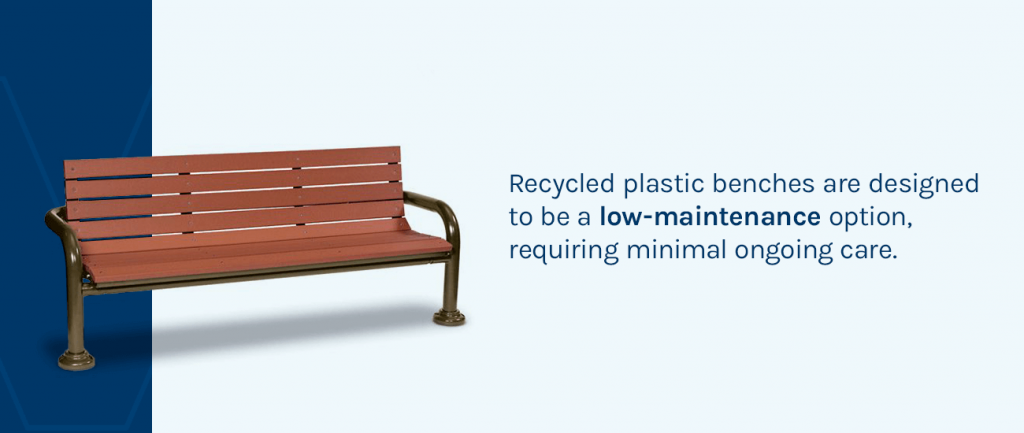How to Choose the Right Bench Material

Product Guide | Sep 23, 2021
When designing the ideal bench for your needs, you should consider many factors. From style, size, color and other preferences to durability, functionality and maintenance requirements, you need to make many decisions to choose the best type of bench. One of the most important decisions to look at when designing your bench is the type of material to construct it from, with the classic three choices being recycled plastic, metal or wood.
This outdoor furniture materials guide compares your bench material options, detailing the benefits of each one for outdoor furnishings. Our guide also walks you through some of the critical factors to consider when choosing bench material, as well as some frequently asked questions about outdoor benches to help you land on the right choice.
What Are Common Types of Bench Materials?
Outdoor furnishings, including park or public benches, need to be durable so they can stand up to repeated use, weather and other concerns. To design the best bench possible for your requirements, you must choose the right bench material that will give you the look and longevity you desire.
To choose the correct bench material, you need to understand the advantages and disadvantages of each material type. By knowing your priorities for bench material, you can narrow down the perfect option for your outdoor benches.
The primary outdoor bench materials to choose from are recycled plastic, metal and wood.
Recycled Plastic
For organizations looking to meet sustainability objectives, recycled plastic is a good bench material option that aligns with an eco-friendly mission. Recycled plastic is a versatile material that can be molded to suit virtually any style or function. Here are the primary traits of recycled plastic as a bench material:
- Weight: Compared to hardwood or some metals, recycled plastic is lighter weight. This is ideal for situations where you want guests to be able to move the bench and reposition outdoor furnishings.
- Maintenance: Recycled plastic tends to be low maintenance, but this depends on the setting. Benches made from recycled plastic are highly water-resistant. However, thinner plastics may give out over time after ongoing exposure to UV rays.
- Comfort: Recycled plastic benches are generally designed with a higher ductility, or the ability for a material to bend under pressure, which makes them comfortable to sit on. When in direct sunlight, this material tends to heat up quite a bit.
- Aesthetics: With modern manufacturing technology, bench designers can make recycled plastic look elegant, rustic or modern 一 the aesthetic possibilities are endless.
Metal

Whether you’re looking for a polished, glossy look or a style that adds character, metal possesses the properties that make it an excellent material choice for benches. Metal can be fabricated in many different shapes and styles and from a variety of metal types. Consider the following attributes of metal bench material:
- Weight: Metal bench weight varies depending on the type of metal. Steel and cast iron are substantial, while aluminum benches can be much lighter.
- Maintenance: Metal benches tend to be low maintenance, and their durability makes them a long-lasting material. They tend not to show signs of visible wear as prematurely as wood, making them a good choice for city parks, sports complexes and other highly trafficked areas. Metal is also an ideal material for the screws that hold the bench together, especially screws made of durable and rustproof stainless steel.
- Comfort: Unlike recycled plastic, metal bench comfort is a bit more subjective. Some people may find the hardness uncomfortable, but metal benches can be quite comfortable when designed with the proper ratio between hardness and ductility. Like plastic, metal tends to heat up and get quite hot.
- Aesthetics: In terms of style, metal benches can be designed to look sleek and contemporary or elegant and traditional. Because metals are susceptible to rusting, applying a sealant coating that prevents oxidation and maintains the metal’s smooth appearance is crucial.
Wood

Wood is the most traditional outdoor bench material, typically used in parks or on private grounds. These are the main characteristics of wood bench material:
- Weight: Compared to other materials, wood is a medium weight. Its density depends on the species of wood used, with oak, maple, and walnut being heavier hardwoods. Softwoods like pine, cedar and fir are lighter weight.
- Maintenance: Provided the wood materials are adequately sealed, wooden outdoor benches don’t require high maintenance levels. They will be more susceptible to breakages, which can require extensive repairs or total reconstruction to fix. The biggest wear threat to wooden benches is that despite their protective coatings, they’re still susceptible to carving, scraping and scratching.
- Comfort: Similar to recycled plastic, wood can have some give to it depending on the species, which makes it quite comfortable. However, splintering caused by scrapes and scratches may affect the comfort of wooden benches over time. Many people prefer wood over metal or concrete for comfort, but this preference is subjective.
- Aesthetics: Wood’s natural beauty favors outdoor furnishings, especially in forested settings or gardens. While it’s a classic look, wood might feel out of place in a modern, industrial space. Additionally, wood tends to show signs of visible wear and uneven fading much sooner than other materials.
6 Factors to Consider When Choosing Your Type of Bench Material
Since all three bench materials types 一 recycled plastic, metal and wood 一 provide durability, comfort and aesthetic benefits, it can be challenging to choose which material is right for your needs. When selecting bench material, it’s important to consider the application of the bench, the geographical region and the amount of traffic the bench will get. Finally, there’s also a financial consideration. Bench materials can vary widely in cost, depending on many factors, including size, quantity and style.
When choosing your bench material, consider these six factors to help you make your decision.
Weather Resistance

When deciding which bench material is suitable for your setting, consider your climate and the common weather patterns your region experiences. You want to select a material that is most resistant to the type of weather it will encounter.
For example, moderate climates experience very mild temperature changes throughout the year, making all three materials a viable choice. However, extreme climates that experience bitter winters and humid summers may need to avoid wood or plan to weatherproof the material regularly. Because wood retains moisture, it shrinks during the winter and expands again when the weather heats up. Without properly air-proofing the material, the bench will be prone to warping, splitting or cracking as the relative humidity changes.
Both metal and recycled plastics may provide better weather resistance if the bench is directly exposed to the elements. Wood benches are better for sheltered locations to prevent visible wear.
Cleaning and Repair Requirements
To ensure your outdoor benches maintain their appearance and last as long as possible, you will need a strategy for regularly cleaning and repairing them. Certain bench materials are easier to clean and repair than others. The easiest way to clean outdoor furnishings is to use a pressure washer. This will eliminate built-up dirt and grime efficiently. However, pressure washing is best done safely on recycled plastic or metal benches, which can easily withstand the powerful streams of water.
Wooden benches are best washed by hand. If the bench’s protective sealant is wearing off, and you use a pressure washer, water can seep into the material’s pores, eventually leading to warping. This makes wooden benches more laborious to keep clean, which may be a primary concern if you’re managing a large quantity of them.
All three bench types can be repaired, depending on the nature of the damage. From loose bolts to broken slats, each bench material can be dismantled and restored as needed.
Comfort
While comfort is a subjective measurement, some universal criteria exist to examine how well your guests may enjoy sitting on your outdoor benches. Some factors to consider when deciding on comfort level include:
- Temperature: Outdoor benches in non-sheltered areas get much more use on warm, sunny days. Choosing a material that won’t retain heat as much may be a better option. However, there are ways to treat benches so that they insulate better and prevent overheating or freezing.
- Ductility: Extremely hard benches tend to be uncomfortable for prolonged sitting. Meanwhile, materials with higher flexibility tend to be more comfortable. There are ways to construct benches to increase ergonomic comfort even when the material is less ductile.
- Finish: To improve the comfort of your bench, make sure that the finish is as smooth as possible. Small drill holes can become uncomfortable for long rests, so the thicker the material, the smoother it will be. Unfinished or improperly finished materials can cause splintering, peeling or cracking, which disrupt comfort.
Appearance

Along with durability, maintenance and comfort, appearance is an essential factor in how to choose bench material. Outdoor benches come in many different styles, so you can create a cohesive look with your existing hardscaping. You want your benches to appear inviting, offering a place for your guests to rest comfortably.
When choosing bench material, decide on your overall aesthetic. For a more natural look, wood or wood and metal combinations offer a charming rustic style. With metal being such a versatile material, it can create benches that look modern and practical or traditional and refined. Likewise, recycled plastic is another versatile bench material, which can be designed as synthetic wood, recreating the more raw look of a true wooden bench.
Weight

When considering materials, it’s vital to reflect on the functionality of the bench and whether it will be stationary or moveable. Movable benches, such as those in campgrounds or private gardens, should be made from lighter-weight materials, such as softwoods, plastic or aluminum.
When you need your bench to remain stationary to keep your space tidy and safe while preventing theft, it’s better to have a sturdier, heavier material that can be secured to the ground and provide a more substantial presence. Metals and hard plastics tend to be preferred in high-traffic areas, such as retail centers, shopping malls, and public transit stations. They can be built with solid framing and be bolted to or embedded in the ground.
Price
When choosing your bench material, your budget is a crucial factor. Numerous factors determine the price of a bench and which bench material you can afford. Wood can be expensive, particularly if you’re seeking a specific species. If you need many benches, this can potentially make wood an even less affordable option.
Recycled plastic is a readily available and popular material that makes it a budget-friendly option, particularly for retail centers, malls and other businesses that use several benches. Metal benches are more expensive to purchase upfront, but their longevity and low maintenance costs make them an affordable long-term option.
5 Questions to Answer Before Deciding on a Bench Material
With the above factors in mind, you may still need help considering what aspects of a bench will meet your specific needs. Benches can serve a wide variety of purposes and can be found in a range of spaces, from highly trafficked public locations to private properties. By asking yourself who will be using the bench and where it will be located, you can fully assess your bench material needs and make the wisest decision and investment.
When shopping for benches, ask yourself the following questions to help you consider the functionality and location of your bench as well as the type and amount of traffic your bench will accommodate.
1. Who Will Use the Bench?
The first question to ask yourself when deciding on bench material is who will be using the bench the most. If your benches are located in highly trafficked areas, then you’ll get a broad range of people using your outdoor furnishings. From older adults to young children and their parents to everyone in between, the bench needs to be functional for all. Recycled plastic and metal can both withstand this level of heavy use.
For benches on private property, such as on the grounds of condos or office buildings, the traffic will be much lighter than in public areas. Therefore, if you prefer wood for your bench, private grounds are the right setting for this material due to its limited use.
2. What Is the Budget for Your Bench?
Once you understand the type of traffic and wear your bench will undergo, you should determine your budget before making any further decisions. When budgeting for your upcoming investment in outdoor benches, consider the following factors that determine the cost of benches:
- Bench size: The bigger the bench, the more material you’ll need. Therefore, it’s good to select a material that decreases in price the more material you use.
- Quantity: Similarly, when determining which bench material is right for you, consider how many benches in total you need. If you only need one special bench, then compare different materials for a one-time order. If you need dozens of benches, such as for shopping malls, universities or other large institutions, then some materials will be more affordable when ordered in bulk.
- Style details: The level of detail you desire from your bench style can determine the price of the bench. Depending on how intricate your bench style is, it may require more or less material, including a combination of multiple types of material.
- Maintenance costs: In addition to the cost of the material itself, there are also ongoing maintenance costs to consider. Factoring maintenance requirements into your budget can give you a more realistic idea of the actual cost of the bench over time.
3. How Will the Bench Be Used?
When choosing your bench material, it’s also important to consider the purpose of the bench and what function it will serve. This will help you determine the best type of material for the bench’s primary use, the style of the bench and how big it should be.
Here are some examples of different ways that benches are used in different spaces:
- Waiting: These benches are at bus stops, transit stations, airports, shopping malls and retail centers.
- Resting and enjoying: You can find these benches in public parks, green spaces and private grounds.
- Outdoor dining: Restaurants and cafes with outdoor seating use these benches.
- Outdoor learning and meetings: Schools, universities and office and government buildings often include benches for outdoor meeting spaces.
- Recreation: Sports and athletic complexes use benches for their players and fans.
There may also be a special purpose for the bench, such as to honor a loved one. Memorial benches are a way to add beauty and sentimentality to outdoor spaces while remembering someone who enjoyed the space. They’re also a way to offer a generous donation to a local park, charity or other cause on behalf of a departed loved one.
4. How Much Maintenance Can You Commit To?

Since different bench materials require varying degrees of ongoing maintenance, it’s crucial to assess the level of care you can perform. All benches need to be inspected and maintained to some degree. Benches left improperly maintained can become safety hazards that can harm children and adults.
If you desire a bench that is as low-maintenance as possible, then you’ll want to opt for the most durable material and style available. Recycled plastic benches are designed to be a low-maintenance option, requiring minimal ongoing care. Solid plastic benches are much less likely to warp, crack or split compared to wood.
Metal is also another lower maintenance material, although it will need to be refinished periodically to prevent corrosion. Wood benches require more ongoing maintenance, which could be less of a concern if only a small number of them are maintained.
5. Which Bench Style Do You Prefer?
Finally, the last question to ask yourself is which style you prefer. Wood and metal benches are two different styles. Wood benches are generally placed in natural settings surrounded by trees and vegetation, such as parks and gardens. Metal benches are more aesthetically cohesive when placed in urban spaces, including shopping malls, plazas, and other public places.
Recycled plastic offers flexibility in styling. It can be made to look like wood, metal or any other finish, so you can get the ideal style you like while benefiting from the other features this material offers.
Select Your Wabash Valley Outdoor Bench Today
Creating the perfect outdoor bench for your guests is a great investment to add more functionality to your outdoor spaces and provide an area to rest and wait comfortably. High-quality outdoor benches enhance the aesthetic appeal of a property and increase its value as well. Choosing a suitable bench material preserves this investment, providing a durable, long-lasting product for many people to enjoy for years to come.
For all of your outdoor bench needs, choose Wabash Valley Site Furnishings. Whether you’re looking for a single memorial bench or an entire outdoor furnishing solution for large public spaces, Wabash Valley Furnishings can help you select the right bench for your project. Browse our outdoor benches and make the selections you need to find the right bench material, size, and color for you. Our recycled plastic benches are made for longevity and minimal maintenance, preventing warping and retaining durability. Contact us today to learn more about our options on our line of outdoor benches.
Categories
Recent Posts
Sign up for our newsletter
Share this post: